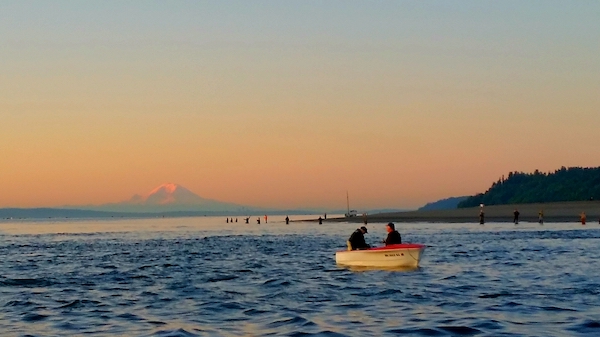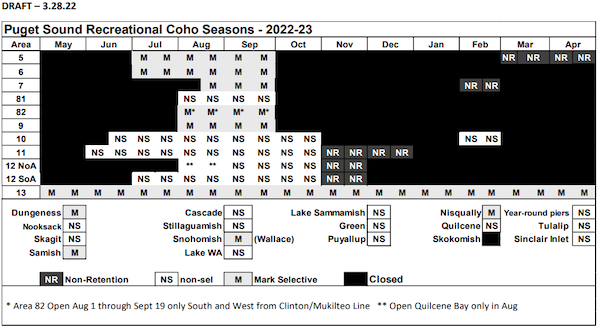Puget Sound Salmon Season Meetings Tonight, Wednesday
Puget Sound 2022-23 salmon fisheries are starting to come into a little better focus – if also a potentially less than ideal one for some anglers – and WDFW’s latest proposals will be the subject of two meetings with recreational fishermen this week.
One is tonight from 6 to 8 p.m. via Zoom to go over preliminary options for the inland sea and its rivers and lakes, and Wednesday from 9 a.m. to 3 p.m., also on Zoom, is “North of Falcon 2” to discuss preferred options for the 2022-23 season.

Probably the biggest open question is whether fishermen will be able to pursue hatchery Chinook this July on two North Sound marine areas.
The seventh month is when we want to be on Admiralty Inlet and the San Juan Islands for kings, but a proposal out this morning from WDFW pencils in August 1 and August 15 starting dates in Areas 9 and 7, respectively.
The former is just over two weeks later than most recent years, the latter a month and a half deeper into summer than 2021’s here-and-gone fishery.

But an agency salmon manager cautions it’s still relatively early in the annual season-setting process before final negotiations with tribal comanangers and July fishing is still an option in both, though underlying issues with low returns of some wild stocks make that a pretty expensive proposition too.
“All these proposals are on the table. It’s just they have consequences,” said WDFW’s Mark Baltzell this morning.
He was reacting to a late Friday post by a Seattle-based radio show that said WDFW was “refusing” to consider July Chinook seasons in Areas 7 and 9.
Tom Nelson, host of The Outdoor Line on 710 ESPN, added on his Saturday morning show that Area 9 anglers had been offered a large August quota of 6,000 hatchery kings, which he labeled an “unrealistic” one as most fish will have moved through the waters off the west side of central and south Whidbey Island.
“I hate hammering on WDFW,” said Nelson following a tangent on the Fish and Wildlife Commission’s recent troubling actions, “but this can’t stand. This can’t stand. If we have anything to do with it, it won’t.”
He also worried that directed August fishing could impact later-returning wild Snoqualmie River kings, digging a deeper hole with ESA-listed Puget Sound stocks.

Baltzell disputed that timing, saying Snoqualmie kings would “pretty much” be in the lower Snohomish River by then, but he did acknowledge Area 9 wouldn’t be as productive in August, especially its northern end.
“He does have a point,” Baltzell said. “Chinook is better in July, but you hit more Stilly and Snohomish Chinook in July.”
Fishery impacts on Stillaguamish kings perennially constrain fisheries, and this year a lower run of Chinook to the Snohomish is compounding things. Managers shave seasons here and there so that on the whole they don’t exceed impact targets.
WDFW is also using a new long-term management plan for Puget Sound kings, so things are going to be “a little different this year than years past,” Baltzell added.

Theoretically, there is room for counterproposals from recreational anglers, but the sense I got from Baltzell is that his agency is aiming for a continuous late-summer two-species salmon fishery in Areas 7 and 9.
That is, feathering from August hatchery Chinook into September hatchery coho – silver returns are expected to be more plentiful this year – instead of a bifurcated one or something like last year, where there just weren’t any Area 7 king impacts available to reopen the islands for September coho.
“I can imagine a scenario [with a July Chinook fishery] where Area 9 is done after Labor Day,” Baltzell warned.
Responding to Nelson’s allegation that the radio show host had heard nothing but “crickets” in response to his Friday emailed question of what sort of July quota might be available for Area 9, Baltzell said he had been in two meetings with comanagers and that, down several staffers, he had also been holding job interviews.`
- Proposed Puget Sound Chinook options – updated as of March 28, 2022
- Proposed Puget Sound coho options – updated as of March 28, 2022
- Proposed Puget Sound Marine Area Salmon Seasons 2022-23 – updated as of March 28, 2022
- Proposed freshwater regulation changes – updated as of March 28, 2022
He said the idea that WDFW hasn’t been responsive to anglers was “ridiculous” and he said that nobody wants to give up Chinook opportunities either.
It boils down to ESA constraints and having to make choices about where to burn impacts.
“We’re in a box that’s not a good box to be in. When we don’t have wild fish, that’s an issue,” Baltzell said.

